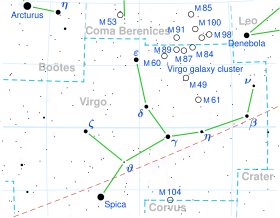Star in the constellation Virgo
Omicron Virginis (ο Vir, ο Virginis) is a star in the zodiac constellation of Virgo. It is visible to the naked eye with an apparent visual magnitude of +4.12.[5] Based upon parallax measurements, it is about 163 light years from the Sun.
ο Virginis is a G-type giant star with a stellar classification of G8 IIIa CN-1Ba1CH1.[3] This indicates that it is a Barium star. Typically Barium stars are close binaries with a white dwarf companion, but no companion has been detected for ο Virginis.[6] It has been suggested that an excess SiIV emission flux is due to an unseen white dwarf companion.[7]
ο Virginis is a giant star around ten times larger than the Sun. Although it is slightly cooler, it is radiating about 60-132 times the luminosity of the Sun. It is over twice as massive as the Sun and is around a billion years old.[5][4] A simplified statistical analysis suggests that ο Virginis is likely to be a red giant branch star fusing hydrogen in a shell around an inert helium core, but there is about a 22% chance that it is a horizontal branch star fusing helium in its core.[8]
References
- ^ a b c d e van Leeuwen, F. (2007), "Validation of the new Hipparcos reduction", Astronomy and Astrophysics, 474 (2): 653–664, arXiv:0708.1752, Bibcode:2007A&A...474..653V, doi:10.1051/0004-6361:20078357, S2CID 18759600.
- ^ Mallik, Sushma V. (December 1999), "Lithium abundance and mass", Astronomy and Astrophysics, 352: 495–507, Bibcode:1999A&A...352..495M.
- ^ a b Keenan, Philip C.; McNeil, Raymond C. (1989), "The Perkins catalog of revised MK types for the cooler stars", Astrophysical Journal Supplement Series, 71: 245, Bibcode:1989ApJS...71..245K, doi:10.1086/191373.
- ^ a b c Jofré, E.; Petrucci, R.; Saffe, C.; Saker, L.; de la Villarmois, E. Artur; Chavero, C.; Gómez, M.; Mauas, P. J. D. (2015). "Stellar parameters and chemical abundances of 223 evolved stars with and without planets". Astronomy & Astrophysics. 574: A50. arXiv:1410.6422. Bibcode:2015A&A...574A..50J. doi:10.1051/0004-6361/201424474. S2CID 53666931.
- ^ a b c Takeda, Yoichi; et al. (August 2008), "Stellar Parameters and Elemental Abundances of Late-G Giants", Publications of the Astronomical Society of Japan, 60 (4): 781–802, arXiv:0805.2434, Bibcode:2008PASJ...60..781T, doi:10.1093/pasj/60.4.781.
- ^ Začs, Laimons (2000). "The Chemical Composition and Orbital Parameters of Barium Stars". The Carbon Star Phenomenon. 177: 277–284. Bibcode:2000IAUS..177..277Z. doi:10.1017/s0074180900002503.
- ^ Böhm-Vitense, Erika; Carpenter, Kenneth; Robinson, Richard; Ake, Tom; Brown, Jeffery (2000). "Do All BA II Stars Have White Dwarf Companions?". The Astrophysical Journal. 533 (2): 969. Bibcode:2000ApJ...533..969B. doi:10.1086/308678.
- ^ Reffert, Sabine; Bergmann, Christoph; Quirrenbach, Andreas; Trifonov, Trifon; Künstler, Andreas (2015). "Precise radial velocities of giant stars. VII. Occurrence rate of giant extrasolar planets as a function of mass and metallicity". Astronomy & Astrophysics. 574: A116. arXiv:1412.4634. Bibcode:2015A&A...574A.116R. doi:10.1051/0004-6361/201322360. hdl:10722/215277. S2CID 59334290.


 Category
Category











